This website stores cookies on your computer. These cookies are used to improve your website experience and
provide
more personalized services to you, both on this website and through other media. To find out more about the
cookies
we
use, see our Privacy Policy.
We won't track your information when you visit our site. But in order to comply with your preferences, we'll have
to
use just one tiny cookie so that you're not asked to make this choice again.
One application of potentiostat/galvanostat- electrocatalysis (OER)
Source:Corrtest
Time:2021-12-22
View:0
Background
With the rapid increase in global energy demand, the burning of fossil fuels has caused a series of environmental problems. Researchers at home and abroad are committed to exploring clean energy and environmentally friendly and efficient energy storage and conversion devices. With the advantages of abundant resources, clean and efficient, high energy density, and environmental friendliness, hydrogen energy is an ideal renewable energy source. However, the sourcing and storage of hydrogen is one of the key factors restricting its development. The current hydrogen production methods include fossil fuel hydrogen production, biomass as raw material hydrogen production, and water splitting. Among them, hydrogen production by water splitting is increasingly attracting people's attention due to the advantages of green environmental protection, sustainability and ease of industrialization, etc. Water splitting involves oxygen evolution reaction (OER) and hydrogen evolution reaction (HER). These electrocatalytic reactions, especially the OER, have slow kinetic rate, leading to high overpotential and low efficiency which severely restricts the development and practical application of energy conversion devices. The use of electrocatalyst can effectively reduce the energy barrier of the electrocatalytic reaction, accelerate the reaction rate, and reduce the overpotential so that the OER can be effectively completed, thereby improving the working efficiency of the conversion device. Therefore, exploring OER electrocatalysts with high performance has become one of the key factors to improve the performance of energy conversion devices.
Theory
The OER is an important half reaction of electrochemical energy conversion devices such as water splitting and metal-air batteries. Under acidic and alkaline conditions, the OER is a four-electron process with a slow kinetic rate, which restricts the performance of electrochemical energy conversion devices. Overall performance. According to density functional theory calculation, the OER under acidic and alkaline conditions both involves the adsorption of OOH*, O* and OH* intermediates. The difference is that the first step of OER under acidic conditions is the dissociation of water, and the final product are H+ and O2, while the first step of OER under alkaline conditions is the adsorption of OH-, and the final products are H2O and O2, as is shown in the following formula.
Acid environment:
Overall reaction: 2H2O → 4H+ + O2 + 4e-
* + H2O ⇌ OH* + H+ + e-
OH* ⇌ O* + H+ + e-
O* + H2O ⇌ OOH* + H+ + e-
OOH* ⇌ * + O2 + H+ + e-
Alkaline environment:
Overall reaction: 4OH- → 2H2O + O2 + 4e-
* + OH- ⇌ OH* + e-
OH* + OH- ⇌ O* + H2O + e-
O* + OH- ⇌ OOH* + e-
OOH* + OH- ⇌ * + O2 + H2O + e-
Where, * means the active site on the catalyst surface, and OOH*, O* and OH* indicate adsorption intermediates.
According to the four-step electronic reaction mechanism of OER, the important factors for improving the catalytic performance of OER can be analyzed from a theoretical perspective:
(1) Good conductivity. Since the OER reaction process is a four-electron transfer reaction, good conductivity determines the rapid electron transfer, which helps the progress of each elementary reaction.
(2) The catalyst has strong adsorption for OH-. The greater the amount of OH- adsorbed, the easier it is for the subsequent three-step electronic reactions to proceed.
(3) Strong oxygen chemical desorption capacity and weak oxygen physical adsorption capacity. If the oxygen chemical desorption ability is strong, the O2 molecules produced during the catalytic process are more easily desorbed from the active site of the catalyst; if the oxygen physical adsorption capacity is weak, the O2 molecules are more likely to be precipitated from the electrode surface, and the OER reaction rate can be promoted. This has important guiding significance for the synthesis and preparation of OER catalysts.
Performance evaluation of OER catalyst
Initial potential and overpotential
The initial potential is an important indicator for the catalytic activity of an electrocatalyst. But for the OER process, the initial potential is difficult to observe. Many OER electrocatalysts contain transition metal elements such as Fe, Co, Ni, etc. They will undergo oxidation reactions during the OER process and generate oxidation peaks, which is a great obstacle for the observation of the initial potential. Therefore, in the OER process, it is more scientific and reliable to observe the corresponding overpotential when the current density is 10 10 mA cm-2 or higher.
The overpotential is obtained by linear sweep voltammetry (LSV). Overpotential refers to the difference between the electrode potential (vs. RHE) at a specific current density (usually 10 mA cm-2) and the equilibrium potential of the electrode reaction of 1.23 V, generally in mV. As shown in Figure 1, according to the difference in the overpotential of the OER electrocatalyst at a current density of 10 mA cm-2, the evaluation criteria for its catalytic effect are also different. The smaller the overpotential is, the less energy is required for the reaction, and the better the catalyst activity is. The overpotential of an OER catalyst with ideal catalytic activity is generally between 200~300 mV.
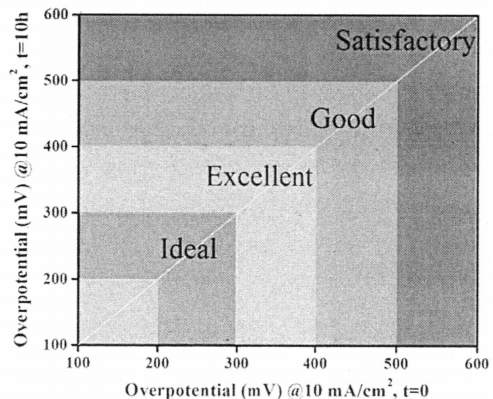
Fig 1. Evaluation criteria of catalytic activity
Tafel slope
Tafel plot is the relationship curve between electrode potential and polarization current. It can reflect the reaction kinetics of the OER process and speculate the mechanism reaction of the OER process. The equation formula is:
η = a + b·log|j|
Where η represents the overpotential, b represents the Tafel slope, j is the current density, and a is the constant. The Tafel slope obtained according to the equation can be used to clarify the kinetics and speed-determining steps in the reaction process. Generally, the smaller the Tafel slope, the less the electron transfer barriers of the catalyst during the catalysis process, and the better the catalytic activity.
Stability
The stability of the catalyst in the catalysis process directly determines whether it can be applied on a large scale in actual production and is one of the important indicators of catalyst performance. For the OER, there are many factors that affect the activity of the OER electrocatalyst. For example, the acidity and basicity of the solution will affect the stability of the catalyst. Many OER electrocatalysts are stable under alkaline conditions, but not good under acidic conditions. In addition, the contact way of the electrocatalyst and the working electrode also has a great influence on the stability. In general, the direct growth of the catalyst in situ on the working electrode will be more stable than the organic adhesion agent on the working electrode.
Currently, there are two electrochemical tests to judge the stability of the catalyst. One is chronopotentiometry (i.e, Galvanostatic). A constant current is applied on the electrode, and then the stability of the electrocatalyst is judged by observing the change of the potential over time. Similarly, the i-t curve (i.e, potentiostatic) is also applicable to test the catalyst. By applying a constant potential on the electrode, observing the change of the current with time, we can determine the stability of the catalyst. The other is to perform thousands or even tens of thousands of cyclic voltammetry (CV) tests on the electrocatalyst in a certain potential sweep range, and judge the stability of the electrocatalyst by comparing the polarization curves of the electrocatalyst before and after the cyclic voltammetry test.
In addition to electrochemical testing, the use of some phase characterization tests such as XRD, XPS, SEM, TEM, etc. to compare the phase changes of the electrocatalyst before and after catalysis can also be used to judge the stability of the electrocatalyst.
Experiment Setup
Instrument: Corrtest potentiostat
WE: Glassy carbon working electrode with catalyst evenly applied on the surface
RE: Ag/AgCl reference electrode
CE: Graphite rod
Solution: 0.1 M KOH
Electrochemical test
Electrocatalyst activity
Technique: Cyclic Voltammetry (CV)
Potential range: 0~1 V (vs. Ag/AgCl)
Scan rate: 50 mV s-1
Technique – Linear Sweep Voltammetry (LSV): Potential range: 0~1V (vs. Ag/AgCl), scan rate 5 mV s-1
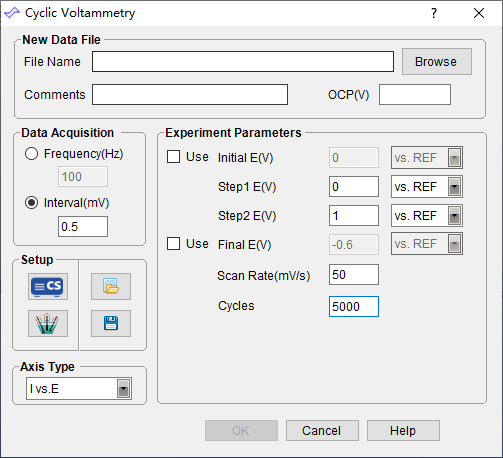
Fig 2. CV parameters setting
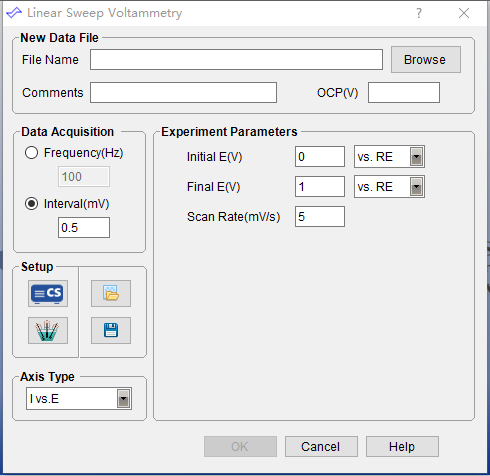
Fig 3. LSV parameters setting
The electrochemical impedance spectroscopy (EIS) is used to study the electrocatalytic oxygen evolution kinetics of the catalyst, and the impedance spectrum is fitted by establishing an equivalent circuit. The circuit includes Rs (solution resistance), Rct (charge transfer resistance) and CPE (constant phase angle element).
The electrochemical impedance (EIS) test conditions are 0.5 V (vs. Ag/AgCl), the frequency test range is 1 Hz ~100 kHz, and the disturbance voltage is 5 mV.
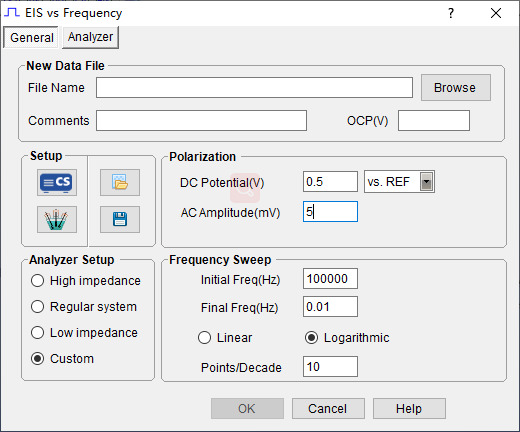
Fig. 4. EIS parameters setting
Electrocatalyst Stability The techniques of potentiostatic, galvanostatic and cyclic voltammetry tests are used to evaluate the catalyst stability. The galvanostatic test is to use the corresponding current under a certain current density (usually 10 mA cm-2) as a constant current output, observe the voltage change during the test time (10 h), and then evaluate the stability. The potentiostatic method is to use the corresponding potential under a certain current density (usually 10 mA cm-2) as a constant voltage output, observe the current change during the test time (10 h), and then evaluate the stability. In the cyclic voltammetry test, the voltage range is 0~1V (vs. Ag/AgCl) and the CV is cyclically scanned 1000 cycles. The stability of the catalyst is illustrated by comparing curves before and after the stability test and analyzing the changes.
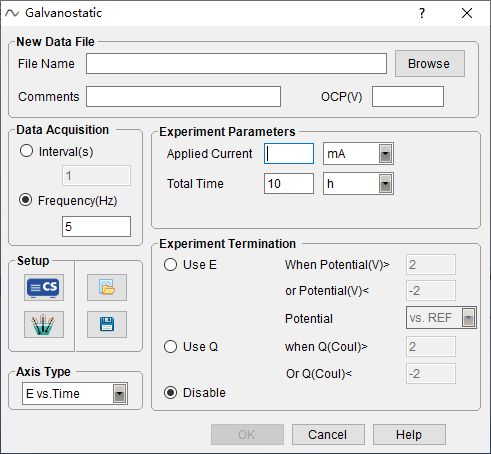
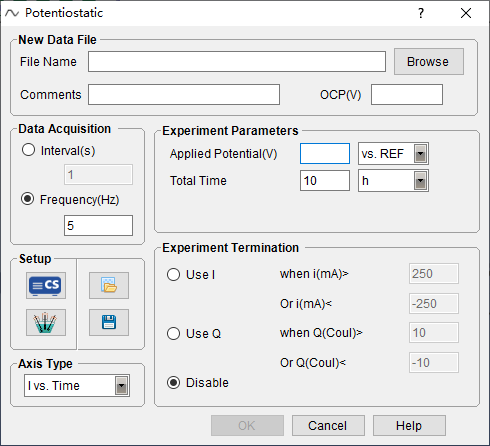
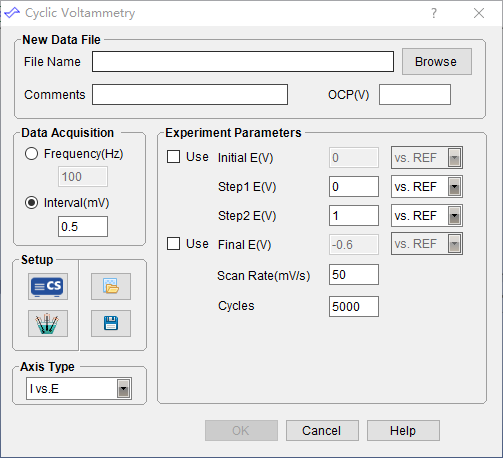
Fig 5. parameters setting
Notices:
- RE: Ag/AgCl electrode should be reserved in darkness without light, and please don’t use in alkaline solution for a long time. Saturated calomel electrode should not be used in alkaline solution for a long time. Hg/HgO electrode is suitable for alkaline solution.
- CE- in long time CV and LSV test, the Pt wire or Pt plate will deposit on the surface of the cathode material. You’d better not use it in the test of non-precious metal materials in monolithic electrolysis cell.
- There are two problems in the glass electrolytic cell: the corrosion of the glass in the alkaline solution and the influence of the Fe impurity of the glass on the OER activity. If the experiment is not particularly accurate, a glass electrolytic cell is OK; but if you want to study the influence of Fe content, it is recommended to use polytetrafluoroethylene.
About Us Potentiostat/Galvanostat Accessories Support Contact Us
Copyright By © 2008-2025 Wuhan Corrtest Instrument Corp., Ltd
 Contact Us
Contact Us +86 13469965984
+86 13469965984
Decline
Accept






